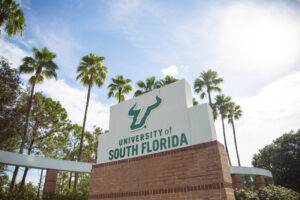Strategic plan focuses on creating diverse community, student success

The USF Strategic Planning Steering Committee’s five-year plan, to be applied across all campuses, is driven by encouraging student and faculty success, increasing partnerships and diversity in the university community and a strong financial base.
Interim President Rhea Law presented the strategic plan, “In Pursuit of Excellence,” on Jan. 25 to the Florida Board of Governors (BOG), seeking and successfully obtaining unanimous approval. It is set to be implemented July 1.
The plan consists of five main goals, 22 objectives, 68 measures of success and 131 granular measurements which are set to be completed by 2027, according to Co-Chair of the Strategic Planning Steering Committee Pritish Mukherjee.
The committee will establish how it’s going to achieve these goals over the spring semester, according to Co-Chair of the Strategic Planning Steering Committee Theresa Chisolm, but there is currently no plan in place for how the goals will get accomplished at this time.
Mukherjee said achieving the goals in a timely manner will depend on community involvement to stay on track for the plan’s projected implementation in July.
“This is work that is in progress, and it’s going to include grassroots involvement by the community as a whole,” he said.
Meetings were held by the committee with stakeholder groups and students from various organizations, including Student Government (SG) and the graduate and professional SG, to get feedback on the goals and objectives of the plan, according to Mukherjee.
Starting in early September, the Strategic Planning Steering Committee also got feedback on the objectives of the plan from the community through a survey to cater to their wants and needs. It received 2,000 responses from all campuses, including from faculty, staff, students, administrators, alumni and community members, according to Mukherjee.
The fourth goal of the plan, “A diverse and inclusive community for learning,” is unique to this strategic plan as the university hopes to focus more on inclusivity and a more diverse learning environment for faculty, staff and students.
While this goal was divided into five subsections, including focuses on recruiting and retaining diverse faculty, staff and students and enhancing academic programs to be inclusive of diverse perspectives, the plan did not not specify how this would be achieved.
The subsection that was voted most important by the community in the digital survey emphasizes the importance of creating a positive work environment for employees that “embraces a dynamic workplace environment.”
“Goal four, and our newly articulated values, expand and strengthen our community to a diverse and inclusive environment and community from creating flexible and adaptive instructional environments in curricula to the recruitment of more diverse faculty, staff and students,” said Mukherjee.
Beyond the fourth goal, many of the other initiatives the university hopes to achieve range from topics such as student success to financial stability.
Goal one focuses on “Student success at USF and beyond.” Details of the plan include to “increase the development and availability of high-impact educational experiences for student success” and “prepare students for professional and leadership success in a competitive environment.”
In order to increase the development of educational experience, the university plans to increase student enrollment in areas such as study abroad and undergraduate research. The purpose of this is to ensure students are career-ready to interact with the world outside of the university.
By preparing students for professional success, the university hopes to improve retention and graduation rates, reduce student debt and improve professional licensure exam pass rates.
Examining faculty achievement in research and innovation is the second goal in the plan, which focuses on how increasing recognition and the development of specific initiatives can lead to stronger success in the field of research for faculty.
One of the points of the goal is to “Enhance institutional infrastructure and operational excellence for faculty success in research and innovation,” by increasing research and development expenditures, postdoctoral appointees and non-faculty S&E research staff with doctorates.
Increasing the recognition of research and innovation is another point of this goal. This will be achieved by improving citation impact, or the number of times a specific text is cited, increasing faculty awards and more.
The main purpose of the third goal is to establish current partnerships, make new ones and strengthen the university’s engagement with the local, corporate, national and global community.
This goal also has a focus to enhance USF’s footprint through national and global partnerships by providing extended student participation in global experiences and to grow attendance of the number of international students enrolled.
Striving to establish “A strong, sustainable and adaptable financial base,” the fifth goal breaks into four points that include establishing a clear budget model, diversifying the revenue streams to support various programs and operations, ensure a cost-effective use of resources and to streamline processes for effective implementation.
The point of this goal is, among other things, to improve relations with the community and USF alumni to create a sustainable financial base, as well as introduce a transparent budget model.
With the implementation of these five goals, the committee hopes USF can become a Top-25 public research university and gain eligibility for membership of the Association of American Universities.
USF is currently No. 46 among all public universities in the U.S. News and World Report 2022 National University Ranking. The university has risen 78 spots among all universities and 54 spots among all public universities in the U.S News and World Report over the past decade.
Mukherjee said the plan will help USF by improving faculty and student success, such as graduation and retention rates. This would in turn enhance institutional reputation leading to an increase in financial support, he said.
The Board of Trustees plans on having regular evaluations of progress to ensure the goals of the plan are being implemented.
“The colleges, academic and student support and business units will be working over the spring to develop strategies and tactics to support the goals and objectives of the approved plan,” said Chisolm.







